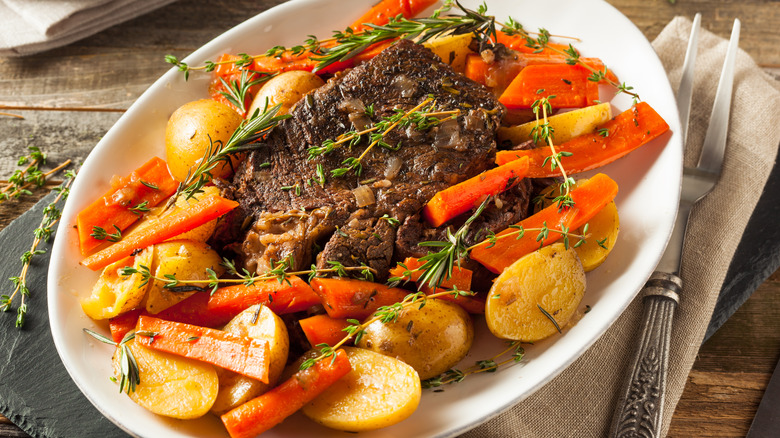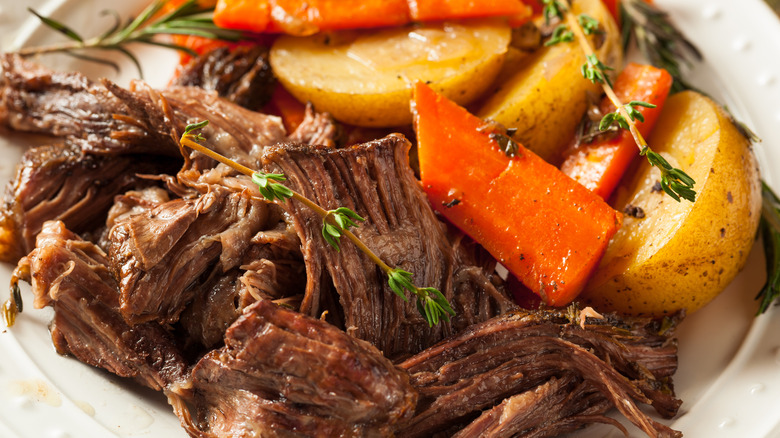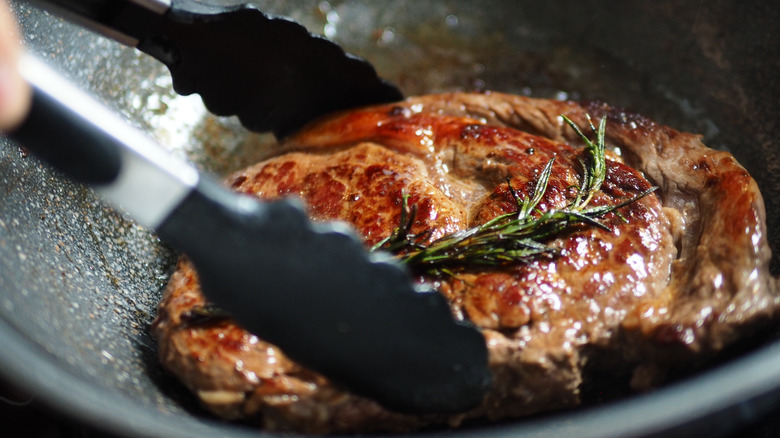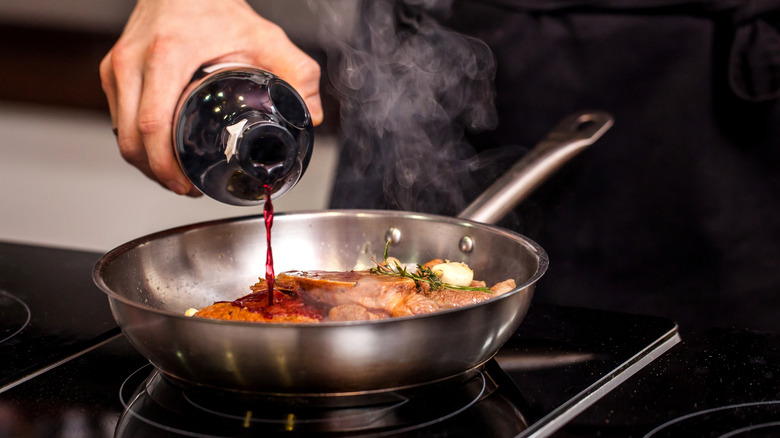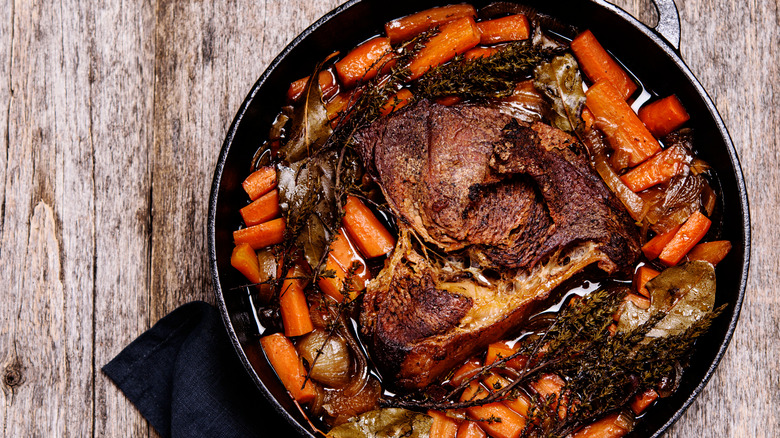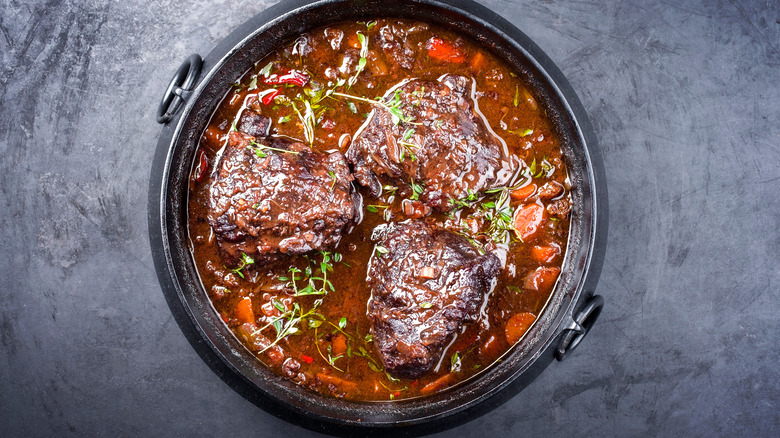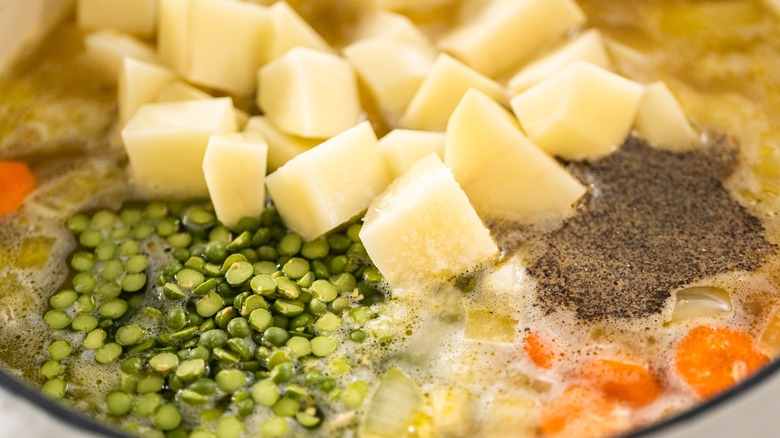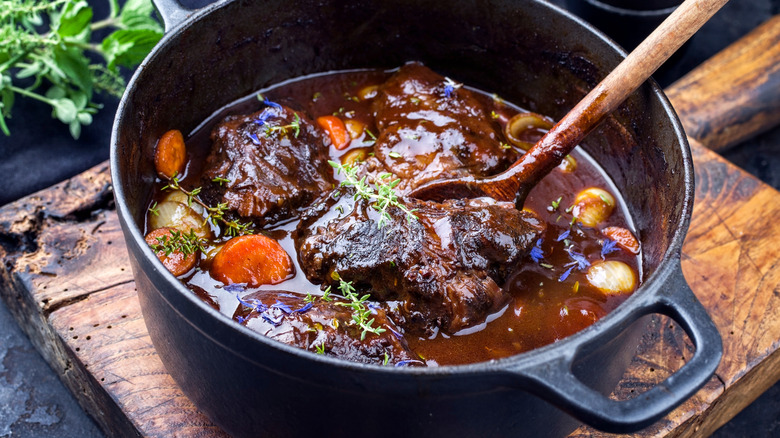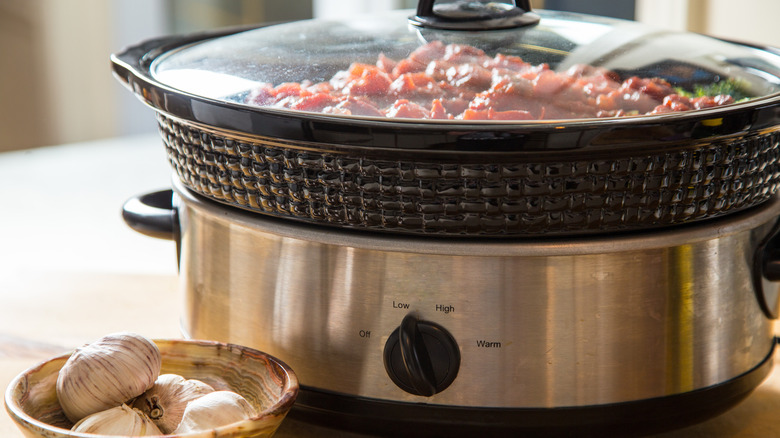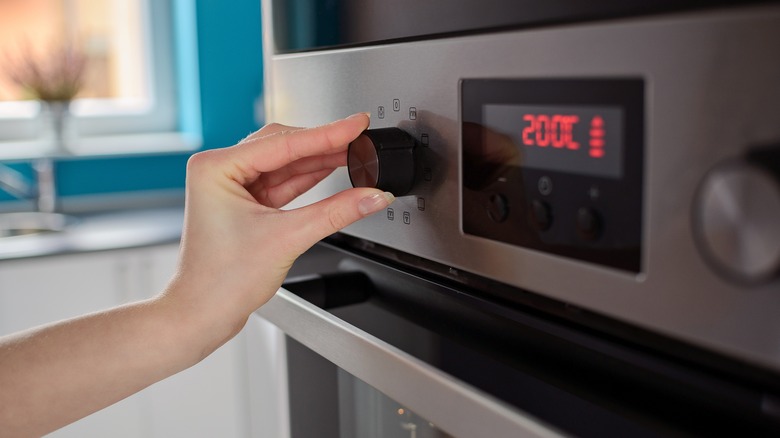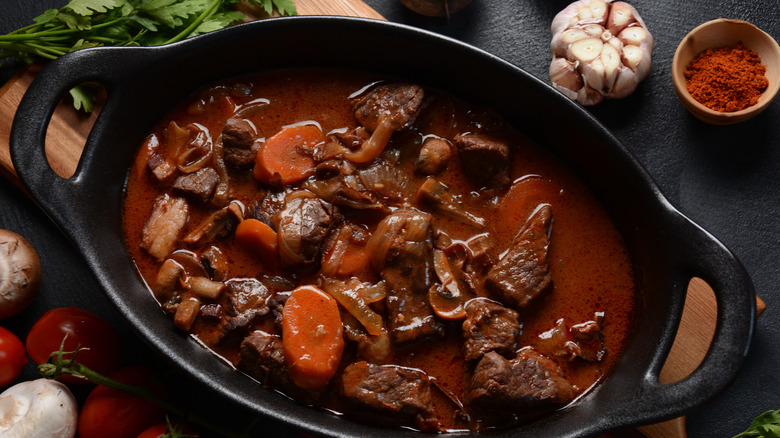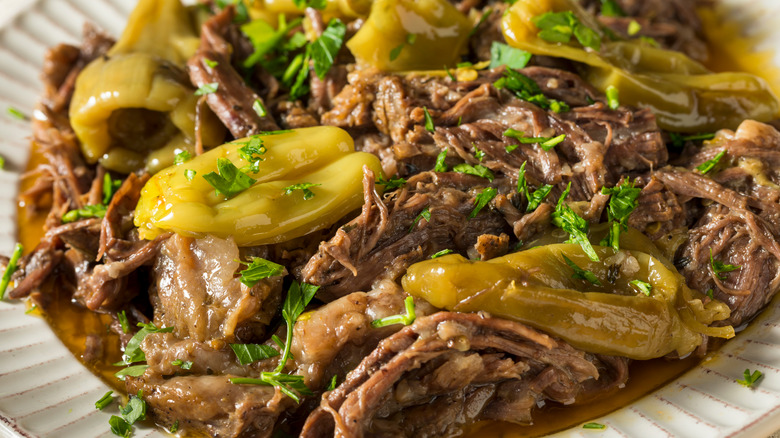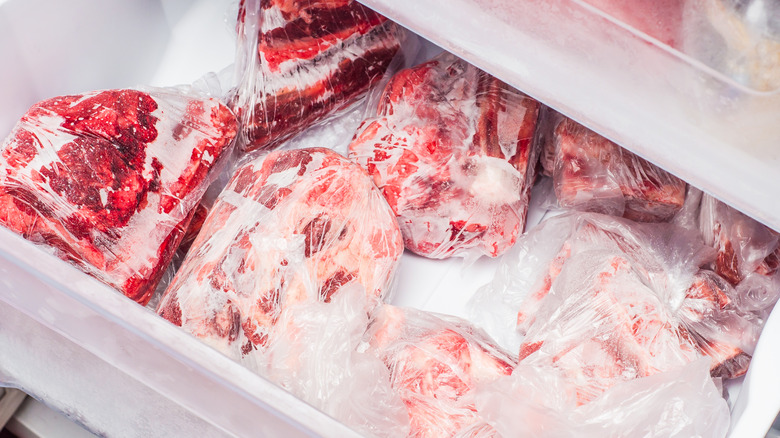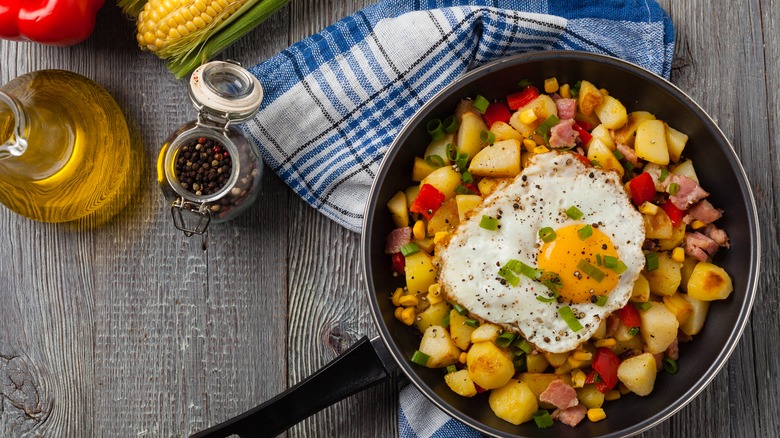13 Biggest Mistakes Everyone Makes With Pot Roast
Pot roast is a cold-weather favorite for several reasons. It's cozy, comforting, and easy to make. And nothing beats the aroma of a slow-cooked meal that's been simmering in the Crockpot during a long day of work. Just a handful of easy-to-find ingredients, your trusty slow cooker, and a few hours are all you need to have a satisfying dinner on the table, even on busy weeknights.
A classic pot roast recipe combines an affordable cut of meat with simple vegetables and a flavorful cooking liquid. The protein cooks low and slow for hours, becoming melt-in-your-mouth tender and full of rich, beefy flavor. While the vegetables can be customized to fit your personal taste. Carrots and potatoes are a classic pairing for this dish, but you can also try green beans, celery, pearl onions, or turnips. The beauty of this dish is its simplicity and flexibility with ingredients. But even a simple recipe with easy-to-follow instructions has its challenges. Don't fall victim to these common mistakes everyone makes with pot roast.
Not using the right cut of meat
One of the best things about this cozy dish is that the best cuts of meat for pot roast are also often the most affordable. Tougher proteins that don't grill or sauté well are excellent contenders for a slow-cooked meal. These cuts are loaded with connective tissues and the tissues break down over long periods, creating a more tender texture after being braised or slow cooked for hours.
What are some of the best cuts of meat for pot roast? Chuck roast, brisket, and bottom round are three delicious and affordable options for this slow-cooked wonder. These pieces of beef cook down beautifully to make a melt-in-your-mouth plateful. You'll want to avoid cuts like tenderloin or ribeye as they don't contain the high amounts of collagen, which breaks down into gelatin, as the tougher cuts of meat do (via the University of Nebraska-Lincoln). This means they won't stay as moist or be nearly as tender as they would be with a quicker sear on the grill.
Failing to brown the beef before cooking
The slow cooker and pot roast are a match made in heaven. A slow cooker allows you to add everything to the pot at once, set the temperature, and not worry about the meal until you're ready to serve. Slow-cooked beef chuck is an ideal recipe for this cooking method. However, there is one important step you should take putting beef in the slow cooker. You should always sear or brown your protein before slow cooking it. According to the University of Iowa, a slow cooker maxes out around 300 F, but this is the minimum temperature at which the Maillard reaction actually works — this is the reaction that occurs when you sear your meat.
Browning meat before adding it to the slow cooker does two very important things. First, it adds depth of flavor and a caramelized taste, along with giving the protein a gorgeous color and better texture. And the second reason to brown beef before adding it to your slow cooker? This step gives you a flavorful base to create a sauce or gravy after deglazing the pan. What would this decadent dinner be without a luscious and flavorful gravy to drizzle on top?
Forgetting to deglaze the pan
After browning, you should always deglaze your pan. This is the second most important step in creating a savory meat dish, next to searing the meat first. When browning protein, some bits get stuck to the pan in the process. These bits are called fond, and they are full of flavor. But getting them unstuck is the trick. This is where deglazing comes in. This technique lifts the cooked pieces from the bottom of the pan, creating a flavor-rich liquid you can use in your recipe.
The best way to deglaze pot roast is with an acidic liquid. Many people use beef broth, but that leads to a one-note flavor throughout your meal. Using acid gives a brighter flavor that pairs well with your protein and develops a more full-bodied taste than using water or broth alone. Try red or white wine, or even vinegar, like red wine vinegar, to deglaze and add a perfect bite to your sauce.
Using too much cooking liquid
It makes sense to add your deglazed liquid to your slow cooker to create maximum flavor while cooking your pot roast. But often, many people will take it a step further and add more fluid than necessary. Sometimes even filling the entire slow cooker with water or broth. Not only does this dilute the flavor, but it can also cause the protein and vegetables to cook improperly, resulting in poor taste and texture.
Despite being well-intended advice, adding too much liquid is actually one of the mistakes everyone makes when using a slow cooker. You do not need to submerge the pot roast to cook it thoroughly. In fact, the heat from your slow cooker and the bit of braising liquid from deglazing your pan will be just enough to prepare the food for you perfectly. Much of what you're cooking, in this case, meat and vegetables, will release liquid as they cook. Plus, cooking on low heat in a slow cooker will not reduce liquids the way cooking on a stovetop does. This is one instance where less is definitely more.
Not cooking the pot roast long enough
While it normally pays to whip out your digital meat thermometer and cook beef to a precise level of doneness, pot roast doesn't really abide by the same rules. Yes, you want to cook this cozy meal to a safe internal temperature, which is at least 145 F (per the USDA), but you also want the meat to become fall-apart tender in the process. This sometimes requires cooking it for much longer than the amount of time it takes to reach the minimum internal doneness.
Instead, you should focus on the texture of the meat. With tougher cuts of protein, it takes time to tenderize. Cooking slowly ensures that the muscle fibers break down completely, and according to the Edmonton Journal, this includes the collagen and fats found in the muscle's connective tissue. The slow breakdown of tissue is what creates a tender cut of protein that can be sliced, shredded, or cut with just a fork.
Undercooking or overcooking the vegetables
While the best part of a slow cooker dinner is, arguably, the set it and forget it preparation process, that doesn't always result in the best texture for this savory meal. And unfortunately, there is not a one-size-fits-all rule for how to cook the vegetables either. To avoid undercooking or overcooking the vegetables in this decadent dinner, you may want to add the vegetables to a slow cooker before the meat. This is especially true if your pot roast is on the smaller side and your veggies are large. If you cut your potatoes in half instead of quarters, for instance.
But adding your veggies first isn't a strict rule. If your pot roast is larger and will take quite a while to break down and become tender, and you've quartered your potatoes and used baby carrots, you will have a better outcome by adding the vegetables just an hour or so before the beef finishes cooking. For the most part, as long as you're using good judgment with the size of the ingredients, this cozy feast is still a recipe with very few steps.
Neglecting flavor and seasoning
To create depth of flavor in this rich and savory dinner, do not skimp on the seasoning. Be sure to generously season the beef roast with salt and pepper before browning it. Instead of deglazing the pan with broth or water after browning the meat, use an acidic liquid to bring out the richness of the beef and give the meal a more complex taste. If you do use broth to deglaze the pan, or add a little for some additional cooking liquid, use a low-sodium option and salt the meal to taste. You'll end up with better savoriness overall instead of a one-note salty dish.
Along with seasoning the meat and cooking liquid, you can also add flavor by using spices and fresh herbs. Take a note from this rump roast Crockpot recipe and use rosemary and thyme along with balsamic vinegar. Brown sugar, sweet paprika, and even the tiniest pinch of cinnamon add the unexpected to this classic recipe.
Choosing the wrong cooking method
Using a slow cooker or Crockpot is an easy cooking method for this delicious dinner. It's also common to make this recipe in an Instant Pot pressure cooker or a dutch oven. The time, temperature, and steps may vary depending on which cooking process you choose.
When comparing the Instant Pot vs. Crockpot for beef roast, the latter choice reigns supreme. Because of Crockpot's tried and true slow cooking at a low temperature, the results are decadent protein and a luscious gravy after cooking. The Instant Pot can't quite reproduce that same deep flavor.
That being said, the Instant Pot version cooks several hours quicker than with Crockpot. If you're in a hurry, the Instant Pot method will still result in a flavorful, tender pot roast. It just may not be as rich and moist as the classic Crockpot version.
This savory meal is also commonly braised in a large dutch oven. This method requires a bit more attention as you're using a large kitchen pot with no automated settings, but it's still a relatively set-it-and-forget-it process. Braising the meat in the oven results in a juicy and succulent cut of beef, and many home cooks prefer this method. It's worth noting that if you're cooking this recipe in a dutch oven, adding the vegetables with about an hour left of cook time is best. This is because dutch oven recipes do cook at a higher temperature and so your veggies will cook more quickly.
Cooking at the wrong temperature
Since Crockpots really only give you two temperature options, low and high, it's hard to be precise while cooking this hearty dish. Traditional slow cookers cook at temperatures between 170 F and 280 F (via USDA), and it's good to be aware of this as you cook any protein. Most recipes call for a temperature around 200 F, so the low setting is ideal if you have the time.
Trying to hurry this recipe along using the high setting works, but you'll want to cut the time down to about four hours. Be aware that your protein could shrink in size and have a tough bite. According to Science of Cooking, cooking meat to a medium or well doneness at a higher temperature can result in shrinkage and tougher texture. Whereas cooking meat low and slow results in the breakdown of collagen and a more tender bite.
If you opt for the oven as your cooking method, most recipes call for temperatures between 250 F and 350 F. The lower the temperature, the slower the cook, and the more tender the results.
Not thickening the cooking liquid
After cooking the pot roast, the liquid will be rich, beefy, and tasty. However, it will likely also be pretty thin in consistency; too thin to smother your perfectly cooked beef chuck and vegetables. But here's the fun part. You can turn that liquid into a thick and decadent gravy in no time.
There are a few hacks to fix thin gravy, but our favorite cooking tip is to use a beurre manié. Similar to a roux, a beurre manié uses butter and flour to thicken a sauce. But instead of starting the sauce with a roux by cooking flour and fat together, you use it as a thickening agent after the fact. To make this magic thickener, use a fork to blend equal parts softened butter with flour, creating a paste. Use this mixture in your pot roast recipe to turn the thin cooking liquid into a savory and luscious gravy.
Another tip to thicken gravy happens to include a gluten-free ingredient to thicken sauce. Surprisingly, some gluten-free cooks use dehydrated potato flakes in their sauces to thicken them without adding flour. These flakes dissolve quickly and concentrate while keeping the sauce smooth and rich. For another gluten-free option, you can try Alex Guarnaschelli's secret technique for thickening gravy: puréeing some of the cooked vegetables into a paste and stirring them into the too-thin liquid. This never dilutes the flavor and creates a perfectly silky sauce.
Sticking with the same recipe
Though the allure of this recipe is its classic simplicity, don't be afraid to try something new. The classic version will always be there if you crave it, but nothing beats stumbling across a perfect new recipe by experimenting. It can be as simple as trying a new spice, like the warm and floral notes of garam masala, which goes great with sweet potatoes. Allspice, clove, cumin, or cardamom are all warming spices that add character to this classic dish.
Or you could try adding unique ingredients. Crushed ginger snaps, the secret ingredient that will change your pot roast forever, add a surprising sweetness and slight spice to this hearty beef dish. A Mississippi pot roast recipe calls for pepperoncini peppers and their juice to add an acidic and tangy bite. And some home cooks have substituted ranch seasoning in the Mississippi preparation for Italian seasoning packets or au jus packets instead of the onion soup mix.
Not freezing extras for later
This cozy recipe freezes surprisingly well. You'll want to remove any vegetables before freezing as those won't hold up well in cold temperatures, and the texture will be all wrong when you reheat them. But the beef is an excellent candidate for freezing and reheating when you need a quick and easy meal later.
Cool the cooked protein for up to two hours at room temperature. The USDA states that cooling food for more than two hours outside of the refrigerator is unsafe. Once cooled, place the beef and the gravy in an air-tight container or zip-top bag, removing as much air as you can, and store it in the freezer for up to three months.
To thaw the leftovers safely, be sure not to make any of these common mistakes when defrosting meat. Once thawed, a great method for reheating pot roast is to place it, along with the reserved cooking liquid, in a large dutch oven with the lid on over medium heat. Cook for about 15 minutes until the meat reaches an internal temperature of at least 165 F (via Food Safety and Inspection Service).
Preparing boring leftovers
Leftovers can lead to some amazing new dinner mash-ups. If you do reheat your pot roast after the first delectable meal, don't be afraid to get creative with ways to serve it the second time around. While you can absolutely keep it classic and smother some oven-roasted carrots and mashed potatoes with the reheated protein and sauce, we suggest you also give these leftovers a shot at being the star of a simple shepherd's pie recipe. For a sugary twist, use mashed sweet potatoes for the topping.
Don't just stick to leftover dinner ideas, either. For a hearty breakfast option, you could also try making a roast beef hash recipe. Just dice or shred the leftover beef, add cubed potatoes, red and yellow bell peppers, and slather it with a silky gravy. For added protein and richness, top the beef hash with an over-easy, yolky egg.
